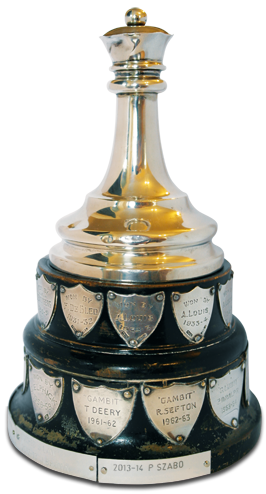
"Once the game is over
the king and the pawn go back
in the same box"
(Italian Proverb)
I play chess more seriously since 2012 and I am a member of the Metropolitan Chess Club in London.
On this page, I collect those things that I have learnt, found interesting and would like to share. You can find here basic chess openings, endgames, tactics, facts and interesting games.
The material below is mainly from Chess.com, Wikipedia, different books or things that I have wrote down at some point.
The "Links & Tools" page has a PGN converter. This tool converts the evaluation values to normal values, so it can be used on Chess.com.
I play chess at Chess.com!
Good To Know
Standard Valuation of Pieces:
Knight Moves:
The diagram below shows how many moves does the knight need to get from one square to another.
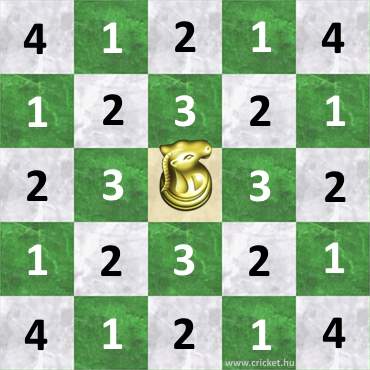
The best position for the king is always diagonally with one square in between from the opponent's knight. Knight needs four moves to get there, which means 3 moves to give check.
Why bishop pair is better than knight pair:
Interesting Articles:
- Pawn - 1
- Knight - 3
- Bishop - 3
- Rook - 5
- Queen - 9
- King - 8
Knight Moves:
The diagram below shows how many moves does the knight need to get from one square to another.

The best position for the king is always diagonally with one square in between from the opponent's knight. Knight needs four moves to get there, which means 3 moves to give check.
Why bishop pair is better than knight pair:
- Range: Bishops can play in both sides. One bishop is worth 3.5, but the bishop pair is worth 8 points.
- Time: One big advantage that bishops have over knights is the fact that they can lose tempos. A bishop can move to the same square in a odd number of moves, while a knight can't.
- Outposts: A bishop does not really need an outpost to work.
A knight is almost always protected by a pawn ( it actually needs to be protected with a pawn to be able to work well), but a bishop is rarely protected by a pawn. - Mate abilities: the bishop pair can mate while the knight pair can't.
- Pawns: A knight does not work well with pawns, while a bishop is really good.
Interesting Articles:
- Tactical Patterns Everyone Should Know: The Knight Kamikaze
- Chess 2
- The Life and Games of Mikhail Tal
- The Inner Game: Short v. Kasparov
- Garry Kasparov on My Great Predecessors
[Created at: 25/07/2014 19:00 / Last modified: 05/11/2016 17:13]
Openings
A00: Hungarian Opening [1. g3]:
Wiki
Chess.com
D06 - D69: Queen's Gambit [1. d4 d5 2. c4]
Wiki
Chess.com
C00-C19: French defence [1.e4 e6]
Wiki
Chess.com
Why Simon Loves The French
C50: Italian Opening - Hungarian Defence [1.e4 e5 2.Nf3 Nc6 3.Bc4 Be7]
Wiki
Chess.com
Youtube
Traps:
The most universal opening trap
Black against queens pawn: 1.d4 e5 2.dxe5 Nc6 3.Nf3 Qe7 4.Bf4 Qb4+
Simple trap that happens every level
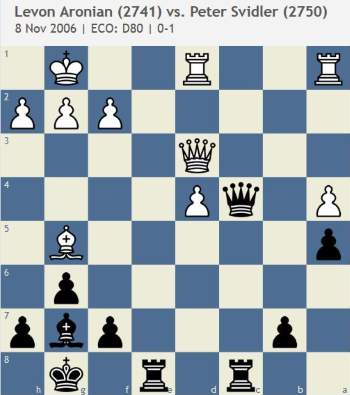
(Black to move)
Books:
Wiki
Chess.com
D06 - D69: Queen's Gambit [1. d4 d5 2. c4]
Wiki
Chess.com
C00-C19: French defence [1.e4 e6]
Wiki
Chess.com
Why Simon Loves The French
C50: Italian Opening - Hungarian Defence [1.e4 e5 2.Nf3 Nc6 3.Bc4 Be7]
Wiki
Chess.com
Youtube
Traps:
The most universal opening trap
Black against queens pawn: 1.d4 e5 2.dxe5 Nc6 3.Nf3 Qe7 4.Bf4 Qb4+
Simple trap that happens every level

(Black to move)
Books:
- Paul Van der Sterren: FCO - Fundamental Chess Openings
[Created at: 25/07/2014 19:00 / Last modified: 05/11/2016 17:14]
Middle Game
Positional differences:
Pawn structure:
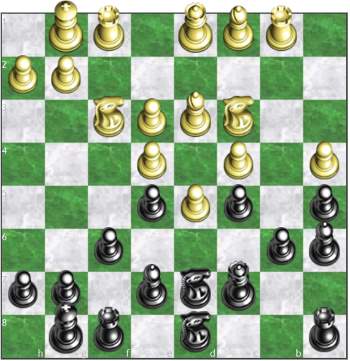
The White pawn on a4 is isolated (no other White pawn is on either side of it or can ever come into contact with it).
The White pawn on d5 is passed (no Black pawn can ever stop its forward progress).
The White e-pawns are doubled (two pawns of the same colour are on the same file).
The Black pawn on b6 is backward. The b6-pawn is unable to move forward, so that it can stand even with its brother pawns.
In general, isolated pawns and backward pawns are weaknesses. This is especially so if they stand on open files where they can be attacked by the opponent's rooks.
Doubled pawns are also considered weak, though they have certain virtues.
Most people consider passed pawns to be something nice to own, and this problem is devoted to Black stopping the White passed pawn on d5.
The knight is the best blockader of passed pawns. (Nf7, Nd6)
Links:
Books:
- Material
The side with more material should try to trade to reach a favourable endgame. The side with less should try to keep as much as possible on the board, thus increasing chances of a successful attack (an endgame is probably not the way to go when you have less on the board) - Minor Piece Play (Two Bishops, Bishop vs Knight etc.)
Bishops are best in positions with an open board (without a locked pawn centre) Knights are best in closed positions (With a locked pawn structure).
The two Bishops are considered an advantage against two Knights or a Bishop and Knight because they work well together.
In endgames, Bishops are best when pawns are on both sides of the board. Knights are better when pawns are on one side. - Space
Space is good to have because it gives your pieces room to breathe, while your opponent's are suffocating. If you don't have as much space, you should look for ways of attacking your opponent's pawn centre, and keep your eyes open for weak squares. - Pawn Structure (Doubled, isolated, backward, Q-side majority, K-side majority etc.)
Isolated pawns can be weak, but also give you an open/half open file.
Doubled pawns have a bad reputation, but can actually help you control squares.
Backward pawns can be awful if they are on an open file, (the rooks can kill them) but if they can't be attacked, they aren't a big deal. If they are vulnerable, a good plan is to trade them off by pushing them.
Passed pawns are good to have most of the time, but not if they can easily be blockaded, (usually by a knight) where they can actually be bad for your game and block your pieces. - Control of a Weak Square (where it can't be defended by a pawn)
What is the point of controlling a weak square? It gets you a good post for a piece, particularly a knight. A square is only weak if it can't be defended by a pawn. A weak square may not sound important, but whole games can be won or lost because of one. - Control of a Key File
Obviously the point of controlling an open file is to increase the activity of your rooks on that file and give you increased attacking potential. - Lead in Development (Who currently has more active pieces out and in the game)
This is typical of the opening phase, but often occurs in the middle game as well. Basically, it is where one side has better developed pieces, or more pieces out. This rarely lasts more than a few moves, (or until the opponent can catch up in development) So you should make use of it quickly or else it will be lost. The best way to make use of it is to try to make an attack of some sort before you lose your lead. There will as often as not be no way to do this, so after thinking about ways to use your lead in development if you can't find anything, just go on with your plan. Just make sure you gave it your all.
For the other side, 1. make sure your king is safe 2. develop your own pieces. - Initiative (Whoever is making the opponent react to your threats has the initiative)
If you have the initiative, you need to use it in a similar way as a lead in development. If you don't make use of it quickly, your initiative will evaporate. Look to make use of it in the way of an attack or combination. The opposing side should just take cover and wait for the tactical bombs to stop falling before surveying the damage and looking for any weaknesses the opponent's onslaught has left behind (for either side.) - King Safety
If your king is safely castled and your opponent's is stuck in the centre, then try to blast it open with all the fire-power you have! The opposing side should just dodge the shrapnel while his/her king rushes to safety.
Pawn structure:

The White pawn on a4 is isolated (no other White pawn is on either side of it or can ever come into contact with it).
The White pawn on d5 is passed (no Black pawn can ever stop its forward progress).
The White e-pawns are doubled (two pawns of the same colour are on the same file).
The Black pawn on b6 is backward. The b6-pawn is unable to move forward, so that it can stand even with its brother pawns.
In general, isolated pawns and backward pawns are weaknesses. This is especially so if they stand on open files where they can be attacked by the opponent's rooks.
Doubled pawns are also considered weak, though they have certain virtues.
Most people consider passed pawns to be something nice to own, and this problem is devoted to Black stopping the White passed pawn on d5.
The knight is the best blockader of passed pawns. (Nf7, Nd6)
Links:
Books:
- How To Reassess Your Chess - Jeremy Silman
[Created at: 25/07/2014 19:00 / Last modified: 05/11/2016 17:16]
Endgame
Draw Positions:
The following positions offer no real winning chances and could be given up as drawn:
The following are drawn if the defending king is not poorly placed in a corner or at the edge of the board:
Opposition:
In simple situation, odd number of squares between the kings means the one who moves does not have the opposition (in line or diagonal)
If there is no direct line and it is white's move then white must step on a same colour square as black where the other two corners are the same then white has the opposition.
King and pawn versus king
When one side has a pawn left and the other side has nothing, the result of the game depends on the placement of the Kings.
If the defending King can get in front of the pawn he will usually draw.
If the attacker's King gets in front of his own pawn the result hinges on who has the opposition.
The rule for such situations is: Get the opposition, advance your King as far forward as possible until your pawn is in danger.
In general, if the defender's King can get in front of the pawn the game will be drawn with ease. If taking the Opposition fails to accomplish the goal of getting the King in front of its pawn, then it's useless to take the Opposition in the first place.
The rule is as follows:
Jump in front of the pawn whenever possible. When you have to move out of its way, always go straight back with your King.
The reason for this is that when the White King comes forward you can step in front of him and take the opposition. Repeat these steps until a stalemate results.
King and Rook vs. King and pawn
Always trap the enemy King as far away from the action as possible.
The attacker wants to advance his King on the opposite side of the enemy monarch while the defender wants to place his own King on the same side, so that it gets in the White King's way.
A Rook can stop two connected pawns if they are not both on the sixth rank.
King vs. King, Bishop and a pawn
This can be a draw if all of the following is true
Knight or Bishop:
At the endgame if the opponent has two pawn islands then the bishop is better.
If there is only one pawn island then knight is better.
Trébuchet
Whoever moves loses
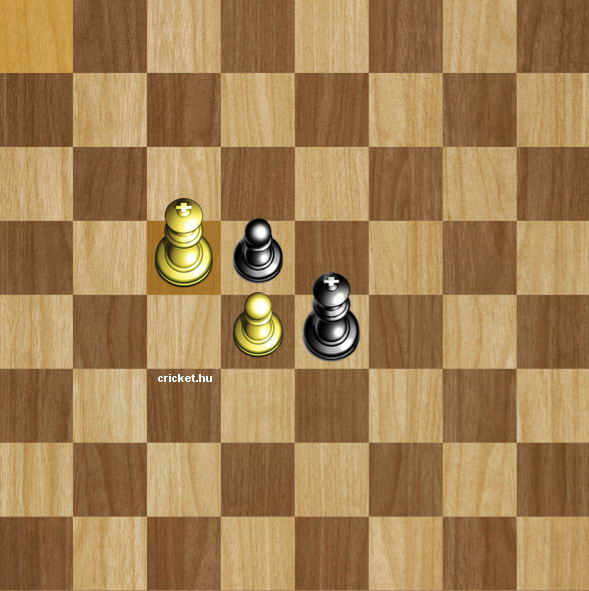
Outflanking
It is maneuver where the stronger side's King moves to the side, placing a file between the Kings (sometimes giving the Opposition to the opponent even). This allows the Outflanking King to march forward towards the target, without allowing the enemy to step in front of it and take Direct Opposition.
Example 1
Example 2
Lucena Position
Wiki
Chess.com
Philidor Position
Wiki
Fortress
Wiki
Bishop and knight checkmate...
Wiki
Zoldsakk.hu
Links:
10 Must Know Endgames Step-by-Step: The Ultimate Endgame Tutorial
Books:
The following positions offer no real winning chances and could be given up as drawn:
- king + minor piece vs. king + minor piece
- king + two knights vs. king (just make sure to keep your king out of the corner)
- king + rook vs. king + rook
- king + queen vs. king + queen
The following are drawn if the defending king is not poorly placed in a corner or at the edge of the board:
- king + rook vs. king + knight
- king + rook vs. king + bishop
- king + rook + knight vs. king + rook
- king + rook + bishop vs. king + rook is drawn
but it is very tough and if you have the extra bishop you should play it out.
Opposition:
In simple situation, odd number of squares between the kings means the one who moves does not have the opposition (in line or diagonal)
If there is no direct line and it is white's move then white must step on a same colour square as black where the other two corners are the same then white has the opposition.
King and pawn versus king
When one side has a pawn left and the other side has nothing, the result of the game depends on the placement of the Kings.
If the defending King can get in front of the pawn he will usually draw.
If the attacker's King gets in front of his own pawn the result hinges on who has the opposition.
The rule for such situations is: Get the opposition, advance your King as far forward as possible until your pawn is in danger.
In general, if the defender's King can get in front of the pawn the game will be drawn with ease. If taking the Opposition fails to accomplish the goal of getting the King in front of its pawn, then it's useless to take the Opposition in the first place.
The rule is as follows:
Jump in front of the pawn whenever possible. When you have to move out of its way, always go straight back with your King.
The reason for this is that when the White King comes forward you can step in front of him and take the opposition. Repeat these steps until a stalemate results.
King and Rook vs. King and pawn
Always trap the enemy King as far away from the action as possible.
The attacker wants to advance his King on the opposite side of the enemy monarch while the defender wants to place his own King on the same side, so that it gets in the White King's way.
A Rook can stop two connected pawns if they are not both on the sixth rank.
King vs. King, Bishop and a pawn
This can be a draw if all of the following is true
- the pawn is a rook pawn
- the pawn's queening square is a different colour than its Bishop
- defenders King can reach the queening square (or any of the squares touching the queening square)
Knight or Bishop:
At the endgame if the opponent has two pawn islands then the bishop is better.
If there is only one pawn island then knight is better.
Trébuchet
Whoever moves loses

Outflanking
It is maneuver where the stronger side's King moves to the side, placing a file between the Kings (sometimes giving the Opposition to the opponent even). This allows the Outflanking King to march forward towards the target, without allowing the enemy to step in front of it and take Direct Opposition.
Example 1
Example 2
Lucena Position
Wiki
Chess.com
Philidor Position
Wiki
Fortress
Wiki
Bishop and knight checkmate...
Wiki
Zoldsakk.hu
Links:
10 Must Know Endgames Step-by-Step: The Ultimate Endgame Tutorial
Books:
- Silman's Complete Endgame Course: From Beginner to Master
- Averbakh's Chess Endings: Essential Knowledge
- Van Perlo: Endgame Tactics
- Soltis books: chess master; how to study chess; pawn structure chess
[Created at: 26/07/2014 18:46 / Last modified: 08/12/2016 13:58]
